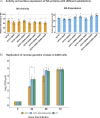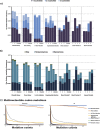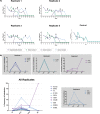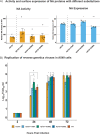Predicting Permissive Mutations That Improve the Fitness of A(H1N1)pdm09 Viruses Bearing the H275Y Neuraminidase Substitution
- PMID: 35867563
- PMCID: PMC9364793
- DOI: 10.1128/jvi.00918-22
Predicting Permissive Mutations That Improve the Fitness of A(H1N1)pdm09 Viruses Bearing the H275Y Neuraminidase Substitution
Abstract
Oseltamivir-resistant influenza viruses arise due to amino acid mutations in key residues of the viral neuraminidase (NA). These changes often come at a fitness cost; however, it is known that permissive mutations in the viral NA can overcome this cost. This result was observed in former seasonal A(H1N1) viruses in 2007 which expressed the H275Y substitution (N1 numbering) with no apparent fitness cost and lead to widespread oseltamivir resistance. Therefore, this study aims to predict permissive mutations that may similarly enable fit H275Y variants to arise in currently circulating A(H1N1)pdm09 viruses. The first approach in this study utilized in silico analyses to predict potentially permissive mutations. The second approach involved the generation of a virus library which encompassed all possible NA mutations while keeping H275Y fixed. Fit variants were then selected by serially passaging the virus library either through ferrets by transmission or passaging once in vitro. The fitness impact of selected substitutions was further evaluated experimentally. The computational approach predicted three candidate permissive NA mutations which, in combination with each other, restored the replicative fitness of an H275Y variant. The second approach identified a stringent bottleneck during transmission between ferrets; however, three further substitutions were identified which may improve transmissibility. A comparison of fit H275Y variants in vitro and in experimentally infected animals showed a statistically significant correlation in the variants that were positively selected. Overall, this study provides valuable tools and insights into potential permissive mutations that may facilitate the emergence of a fit H275Y A(H1N1)pdm09 variant. IMPORTANCE Oseltamivir (Tamiflu) is the most widely used antiviral for the treatment of influenza infections. Therefore, resistance to oseltamivir is a public health concern. This study is important as it explores the different evolutionary pathways available to current circulating influenza viruses that may lead to widespread oseltamivir resistance. Specifically, this study develops valuable experimental and computational tools to evaluate the fitness landscape of circulating A(H1N1)pmd09 influenza viruses bearing the H275Y mutation. The H275Y substitution is most commonly reported to confer oseltamivir resistance but also leads to loss of virus replication and transmission fitness, which limits its spread. However, it is known from previous influenza seasons that influenza viruses can evolve to overcome this loss of fitness. Therefore, this study aims to prospectively predict how contemporary A(H1N1)pmd09 influenza viruses may evolve to overcome the fitness cost of bearing the H275Y NA substitution, which could result in widespread oseltamivir resistance.
Keywords: antivirals; influenza; oseltamivir; resistance.
Conflict of interest statement
The authors declare no conflict of interest.
Figures







Similar articles
-
Impact of potential permissive neuraminidase mutations on viral fitness of the H275Y oseltamivir-resistant influenza A(H1N1)pdm09 virus in vitro, in mice and in ferrets.J Virol. 2014 Feb;88(3):1652-8. doi: 10.1128/JVI.02681-13. Epub 2013 Nov 20. J Virol. 2014. PMID: 24257597 Free PMC article.
-
Estimating the fitness advantage conferred by permissive neuraminidase mutations in recent oseltamivir-resistant A(H1N1)pdm09 influenza viruses.PLoS Pathog. 2014 Apr 3;10(4):e1004065. doi: 10.1371/journal.ppat.1004065. eCollection 2014 Apr. PLoS Pathog. 2014. PMID: 24699865 Free PMC article.
-
Permissive changes in the neuraminidase play a dominant role in improving the viral fitness of oseltamivir-resistant seasonal influenza A(H1N1) strains.Antiviral Res. 2015 Feb;114:57-61. doi: 10.1016/j.antiviral.2014.12.006. Epub 2014 Dec 12. Antiviral Res. 2015. PMID: 25512229
-
The epidemiology and spread of drug resistant human influenza viruses.Curr Opin Virol. 2014 Oct;8:22-9. doi: 10.1016/j.coviro.2014.04.009. Epub 2014 May 24. Curr Opin Virol. 2014. PMID: 24866471 Review.
-
Detection and management of antiviral resistance for influenza viruses.Influenza Other Respir Viruses. 2013 Nov;7 Suppl 3(Suppl 3):18-23. doi: 10.1111/irv.12176. Influenza Other Respir Viruses. 2013. PMID: 24215378 Free PMC article. Review.
Cited by
-
Integrated virtual screening and compound generation targeting H275Y mutation in the neuraminidase gene of oseltamivir-resistant influenza strains.Mol Divers. 2025 Mar 14. doi: 10.1007/s11030-025-11163-0. Online ahead of print. Mol Divers. 2025. PMID: 40085404
-
Mutations in the influenza virus, primarily H5N1, enhance the virus's virulence, favor receptor interaction, and increase drug resistance.Int J Surg. 2025 Jun 1;111(6):4128-4131. doi: 10.1097/JS9.0000000000002403. Epub 2025 Apr 22. Int J Surg. 2025. PMID: 40265471 Free PMC article. No abstract available.
-
Efficacy of favipiravir against influenza virus resistant to both baloxavir and neuraminidase inhibitors.J Antimicrob Chemother. 2023 Jul 5;78(7):1649-1657. doi: 10.1093/jac/dkad145. J Antimicrob Chemother. 2023. PMID: 37209424 Free PMC article.
-
Insights into Genetic and Antigenic Characteristics of Influenza A(H1N1)pdm09 Viruses Circulating in Sicily During the Surveillance Season 2023-2024: The Potential Effect on the Seasonal Vaccine Effectiveness.Viruses. 2024 Oct 21;16(10):1644. doi: 10.3390/v16101644. Viruses. 2024. PMID: 39459976 Free PMC article.
-
Bisbenzylisoquinoline alkaloids inhibit influenza virus replication by disrupting endosomal acidification.Virol J. 2025 Jun 4;22(1):181. doi: 10.1186/s12985-025-02775-x. Virol J. 2025. PMID: 40468427 Free PMC article.
References
-
- Gubareva LV, Besselaar TG, Daniels RS, Fry A, Gregory V, Huang W, Hurt AC, Jorquera PA, Lackenby A, Leang S-K, Lo J, Pereyaslov D, Rebelo-de-Andrade H, Siqueira MM, Takashita E, Odagiri T, Wang D, Zhang W, Meijer A. 2017. Global update on the susceptibility of human influenza viruses to neuraminidase inhibitors, 2015–2016. Antiviral Res 146:12–20. 10.1016/j.antiviral.2017.08.004. - DOI - PMC - PubMed
-
- Hurt AC, Besselaar TG, Daniels RS, Ermetal B, Fry A, Gubareva L, Huang W, Lackenby A, Lee RTC, Lo J, Maurer-Stroh S, Nguyen HT, Pereyaslov D, Rebelo-de-Andrade H, Siqueira MM, Takashita E, Tashiro M, Tilmanis D, Wang D, Zhang W, Meijer A. 2016. Global update on the susceptibility of human influenza viruses to neuraminidase inhibitors, 2014–2015. Antiviral Res 132:178–185. 10.1016/j.antiviral.2016.06.001. - DOI - PMC - PubMed
-
- Takashita E, Meijer A, Lackenby A, Gubareva L, Rebelo-de-Andrade H, Besselaar T, Fry A, Gregory V, Leang S-K, Huang W, Lo J, Pereyaslov D, Siqueira MM, Wang D, Mak GC, Zhang W, Daniels RS, Hurt AC, Tashiro M. 2015. Global update on the susceptibility of human influenza viruses to neuraminidase inhibitors, 2013-2014. Antiviral Res 117:27–38. 10.1016/j.antiviral.2015.02.003. - DOI - PMC - PubMed
-
- Meijer A, Rebelo-de-Andrade H, Correia V, Besselaar T, Drager-Dayal R, Fry A, Gregory V, Gubareva L, Kageyama T, Lackenby A, Lo J, Odagiri T, Pereyaslov D, Siqueira MM, Takashita E, Tashiro M, Wang D, Wong S, Zhang W, Daniels RS, Hurt AC. 2014. Global update on the susceptibility of human influenza viruses to neuraminidase inhibitors, 2012-2013. Antiviral Res 110:31–41. 10.1016/j.antiviral.2014.07.001. - DOI - PMC - PubMed
-
- Lackenby A, Besselaar TG, Daniels RS, Fry A, Gregory V, Gubareva LV, Huang W, Hurt AC, Leang S-K, Lee RTC, Lo J, Lollis L, Maurer-Stroh S, Odagiri T, Pereyaslov D, Takashita E, Wang D, Zhang W, Meijer A. 2018. Global update on the susceptibility of human influenza viruses to neuraminidase inhibitors and status of novel antivirals, 2016–2017. Antiviral Res 157:38–46. 10.1016/j.antiviral.2018.07.001. - DOI - PMC - PubMed
MeSH terms
Substances
LinkOut - more resources
Full Text Sources

